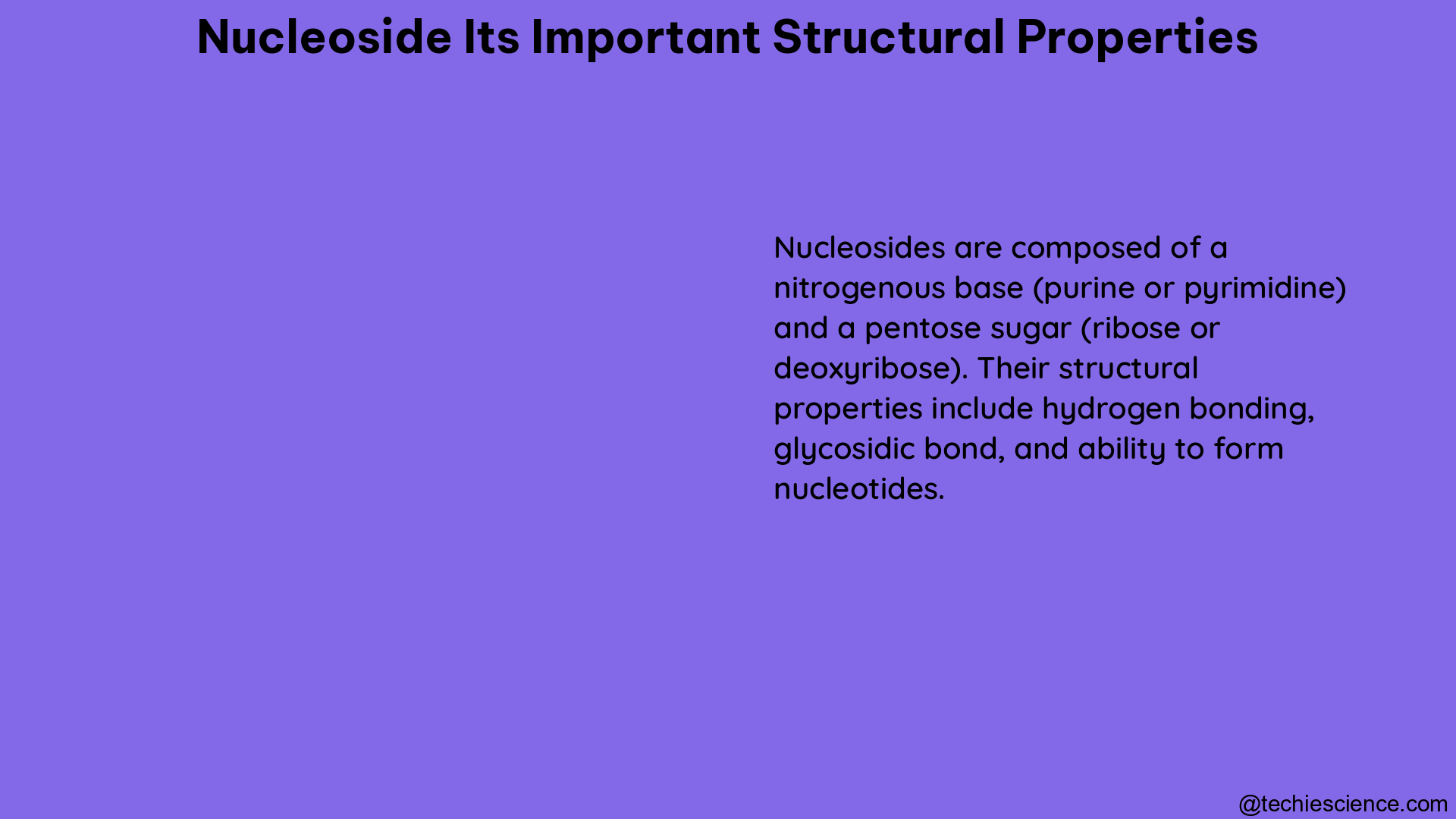Nucleosides are the fundamental building blocks of nucleic acids, DNA and RNA, playing a crucial role in various biological processes. Understanding the intricate structural properties of nucleosides is essential for unraveling their diverse functions within living organisms. In this comprehensive blog post, we will delve into the captivating world of nucleoside structures and their profound impact on cellular dynamics.
Nucleoside Structure: The Backbone of Genetic Information
Nucleosides are composed of a nitrogenous base (adenine, guanine, cytosine, thymine, or uracil) and a pentose sugar (ribose or deoxyribose). This unique combination of a base and a sugar is the foundation upon which the genetic code is stored and transmitted. The structural variations within nucleosides, such as the type of base and the sugar moiety, contribute to their diverse biological functions.
Nitrogenous Bases: The Informational Powerhouses
The nitrogenous bases in nucleosides are classified into two main categories: purines (adenine and guanine) and pyrimidines (cytosine, thymine, and uracil). These bases play a crucial role in the formation of hydrogen bonds, which are essential for the stability and pairing of DNA and RNA strands. The specific arrangement and interactions of these bases determine the genetic information stored within nucleic acids.
Purines: Adenine and Guanine
Purines, such as adenine and guanine, are characterized by a fused double-ring structure. Adenine (A) is composed of a six-membered pyrimidine ring fused to a five-membered imidazole ring, while guanine (G) has a carbonyl group (C=O) at the 6-position of the pyrimidine ring. These structural differences contribute to their unique hydrogen-bonding patterns and interactions within nucleic acids.
Pyrimidines: Cytosine, Thymine, and Uracil
Pyrimidines, including cytosine (C), thymine (T), and uracil (U), have a single six-membered ring structure. Cytosine contains an amino group (NH2) at the 4-position, while thymine and uracil have a carbonyl group (C=O) at the 4-position. The structural variations among pyrimidines influence their hydrogen-bonding capabilities and their roles in DNA and RNA.
Pentose Sugars: Ribose and Deoxyribose
The pentose sugars, ribose and deoxyribose, are the second essential component of nucleosides. Ribose, found in RNA, has a hydroxyl group (-OH) attached to the 2′ carbon of the sugar ring, while deoxyribose, found in DNA, lacks this hydroxyl group. This structural difference between ribose and deoxyribose has significant implications for the stability and function of nucleic acids.
Analytical Techniques for Nucleoside Characterization

Unveiling the structural properties of nucleosides requires the use of advanced analytical techniques. Two prominent methods in this field are High-Resolution Mass Spectrometry (HRMS) and Tandem Mass Spectrometry (MS/MS).
High-Resolution Mass Spectrometry (HRMS)
HRMS techniques, such as Fourier Transform Ion Cyclotron Resonance (FT-ICR) and Orbitrap mass spectrometry, offer unparalleled mass accuracy and resolution. These methods enable the precise determination of nucleoside molecular weights and the identification of their isotopologues. HRMS is particularly valuable for characterizing modified nucleosides, which can provide insights into epigenetic regulation and cellular metabolism.
Tandem Mass Spectrometry (MS/MS)
MS/MS techniques, including Collision-Induced Dissociation (CID) and Higher-Energy Collision Dissociation (HCD), involve the fragmentation of nucleoside ions. The resulting fragmentation patterns provide valuable information for the identification and confirmation of nucleosides and their modifications. MS/MS analysis can reveal the specific structural features of nucleosides, such as the nature of the nitrogenous base and the sugar moiety.
Base Stacking Energies: The Glue that Holds it Together
Base stacking interactions between adjacent nucleobases in DNA and RNA are crucial for the stability and function of nucleic acids. High-throughput single-molecule experiments, such as those using the Constant-Force Method (CFM), have provided unprecedented insights into the quantification of base stacking energies.
These studies have revealed that previous estimates of base stacking energies may have been underestimated. For instance, a single G|A stack has been measured to have a stacking energy of -2.3 kcal/mol, significantly more stable than previously reported dinucleotide stacks containing both G|A and T|C. These refined base stacking energy measurements contribute to our understanding of the structural properties that govern the stability and dynamics of nucleic acids.
Nucleosides vs. Nucleotides: Distinguishing the Structural Differences
It is essential to differentiate between nucleosides and nucleotides, as they possess distinct structural features and functions within biological systems.
Nucleosides are composed of a nitrogenous base and a pentose sugar, as discussed earlier. In contrast, nucleotides include an additional phosphate group or groups attached to the sugar moiety. This structural difference confers critical functions to nucleotides, such as energy transmission, enzymatic processes, and the formation of nucleic acids (DNA and RNA).
The presence of phosphate groups in nucleotides allows for the storage and transfer of energy, as well as the formation of the phosphodiester backbone in nucleic acids. This structural feature is crucial for various cellular processes, including signal transduction, metabolic pathways, and the synthesis of genetic material.
Conclusion
Nucleosides, with their intricate structural properties, are the fundamental building blocks of nucleic acids, DNA and RNA. Understanding the nuances of nucleoside structures, including the nitrogenous bases, pentose sugars, and their interactions, is essential for unraveling the complex mechanisms underlying cellular processes.
The application of advanced analytical techniques, such as High-Resolution Mass Spectrometry and Tandem Mass Spectrometry, has provided unprecedented insights into the structural characterization of nucleosides, including the identification of modified forms. Furthermore, the refined measurements of base stacking energies have shed light on the stability and dynamics of nucleic acid structures.
By delving into the structural secrets of nucleosides, we can gain a deeper appreciation for the pivotal role they play in the maintenance and transmission of genetic information, as well as their involvement in diverse biological functions. This knowledge paves the way for advancements in fields ranging from molecular biology and biotechnology to drug discovery and personalized medicine.
References:
1. Introducing improved structural properties and base stacking energies of DNA and RNA from high-throughput single-molecule experiments
2. Eric Kool’s Research Group
3. Nucleosides: Structure, Metabolism, Functions, and Analytical Techniques
4. Quantifying the sequence-dependent energetics of DNA and RNA base stacking interactions
5. Nucleosides: Structure, Metabolism, Functions, and Analytical Techniques

I am Abdullah Arsalan , Completed my PhD in Biotechnology. I have 7 years of research experience. I have published 6 papers so far in the journals of international repute with an average impact factor of 4.5 and few more are in consideration. I have presented research papers in various national and international conferences. My subject area of interest is biotechnology and biochemistry with special emphasis on Protein chemistry, enzymology, immunology, biophysical techniques and molecular biology.